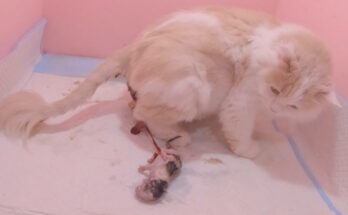Botflies—those ghastly parasites whose larvae tunnel beneath the skin—are uncommon in house-cats, yet when they strike, the results can be downright jaw-dropping. A single larva known as a warble can swell to the size of a marble in just days, but some of the most outrageous cases involve far more than one unwelcome guest.
Take Luna, a sweet barn cat in rural Texas. Her caretaker noticed a “tick” near her shoulder, but when the vet gently pressed on the lump, three separate larvae wriggled their heads into view. Each had carved its own breathing hole, giving Luna the appearance of a peppered sponge. Removing the trio required sedation, forceps, and thirty minutes of meticulous irrigation to prevent toxic rupture.
Even more astounding was Max, a Maine Coon in Oregon whose heavy coat hid an infestation until he began gasping at dinnertime. An emergency X-ray revealed a botfly larva lodged not in skin but in his nasal cavity, blocking airflow like a cork. Extraction demanded delicate endoscopy; the larva emerged intact, twitching dramatically under the operating light. Within hours Max was purring again—his owners still recovering from the spectacle.
Perhaps the most shocking report came from São Paulo, where a stray kitten nicknamed Pipoca arrived at a rescue clinic with twenty-four visible breathing pores. Veterinarians counted thirty-one larvae in total, some clustered so closely they merged into fist-sized abscesses. The team worked in shifts to remove every warble, treat secondary infections, and stabilize the malnourished kitten. Miraculously, Pipoca survived, though her story became a cautionary legend in local shelters.
What unites these nightmarish tales is a simple oversight: botflies often masquerade as harmless bumps. Early detection is the difference between a routine extraction and an anatomical horror show. If you spot a swelling with a pin-size hole, resist the urge to squeeze—ruptured larvae can trigger severe inflammation. Instead, seek veterinary care promptly; professionals will anesthetize, extract the intruder intact, and flush the wound to prevent lingering infection.
Though these cases sound like scenes from a creature feature, they underscore a hopeful truth: with swift attention, even the most shocking botfly infestations can have a happy, purr-filled ending.



